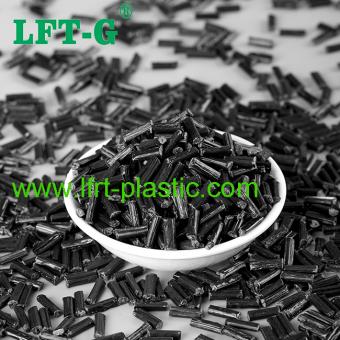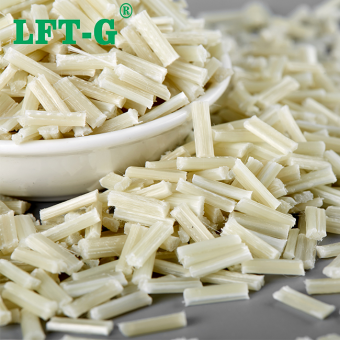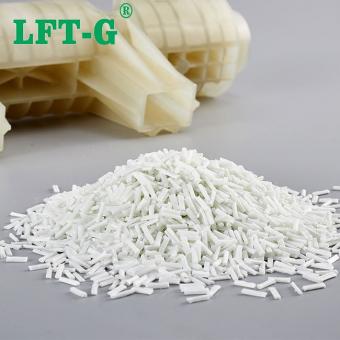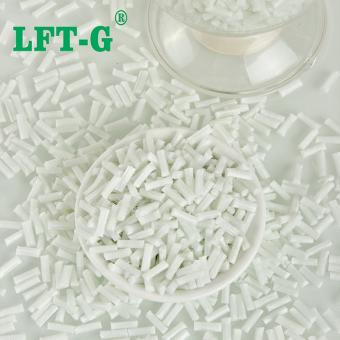-
LFT-G PA66 Nylon66 compound Long Carbon Fiber 20%-60% higher performance injection moldingPolyamide series Nylon is the common name of polyamide (PA), is the general term for thermoplastic resins containing repeated amide groups on the main chain of the molecule, including aliphatic polyamide, aliphatic aromatic polyamide and aromatic polyamide. As the first of the five engineering plastics, nylon has an extremely wide range of industrial applications, mainly used in automotive parts, mechanical parts, electronic and electrical appliances, cosmetics, adhesives and packaging materials and other fields. Among them, aliphatic polyamide, mainly nylon 66, is the most productive and widely used. Polyamide66 Nylon 66 (PA66) is a kind of polyamide formed by the condensation of adipic acid and adipdiamine. The molecular formula is shown in the figure Advantages: high strength, corrosion resistance, good wear resistance, and has self-lubrication, flame retardant, non-toxic environmental protection and other excellent performance. Disadvantages: poor heat and acid resistance, low impact strength in dry state and low temperature, water absorption greatly affects the dimensional stability and electrical properties of products. Long carbon fiber filling PA6 Long carbon fiber is an inorganic polymer material with more than 90% carbon content, which is obtained by carbonization and graphitization of organic fibers. The microstructure of long carbon fiber is similar to that of artificial graphite (C atoms arranged in layers). Advantages: light weight, high strength, high modulus, high temperature resistance, wear resistance, corrosion resistance, fatigue resistance, electrical and thermal conductivity, etc. Disadvantages: high cost, relatively difficult to infiltrate, poor transparency, defects difficult to check, etc. According to the source of carbon fiber, long carbon fiber can be divided into: Polyacrylonitrile-based long carbon fiber Asphaltic long carbon fiber Viscosified long carbon fiber Long carbon fiber composite material is a very useful structural material, it is not only light, high temperature resistance, but also has a high tensile strength and elastic modulus, is the manufacturing of spacecraft, rockets, missiles, high-speed aircraft and large passenger aircraft indispensable components of the material. It is also widely used in transportation, chemical industry, metallurgy, construction and other industrial sectors as well as sports equipment. Datasheet for reference The density of A66/CF composite material is less than 1.3, which is less than one sixth of the density of steel (7.85), achieving the purpose of lightweight, which is conducive to energy saving and consumption reduction. In the PA66/CF composite system, the length of CF is about 0.5 ~ 0.7mm, the interface between PA66 matrix and carbon fiber is fully combined, and nylon 66 is well wrapped around carbon fiber. The fracture surface of PA66/CF sample is rough, and the PA66/CF composite is a ductile material. Compared with PA66, the mechanical properties of PA66/CF composites are significantly improved. Trade fairs we attended Xiamen LFT composite plastic Co., Ltd. is a brand-name company that focuses on LFT&LFRT. Long Glass Fiber Series (LGF) & Long Carbon Fiber Series (LCF). The company's thermoplastic LFT can be used for LFT-G injection molding and extrusion, and can also be used for LFT-D molding. It can be produced according to customer requirements: 5~25mm in length. The company's long-fiber continuous infiltration reinforced thermoplastics have passed ISO9001&16949 system certification, and the products have obtained lots of national trademarks and lots of patents.
- "LFT composite"
- long carbon fiber polyamide pa66
- carbon fiber reinforced plastics granules
- long fiber compounds pa66
- pa66 lcf30
- long fiber composite pa66 granules
Tags :
-
lft-g 2023 hot sell PPA filling lgf long glass fiber customized plastic high toughness for mechnical partsPPA material High temperature nylon is a semi-aromatic polyamide polymer made from terephthalic acid or phthalic acid and aliphatic diamine through polycondensation reaction. Its molecular chain contains benzene ring and diamine flexible long chain, so it has a high crystallization rate and crystallinity. PPA engineering plastics are high performance engineering plastics reinforced by fiber with high temperature nylon as the base material. The structure and crystallization properties of high temperature nylon make it have more characteristics and excellent overall performance than nylon 66 and nylon 6 and other engineering plastics: strong rigidity, high hardness, high temperature resistance, good chemical resistance and low water absorption, dimensional accuracy and stability and low warpiness, excellent fatigue resistance, in many fields including automotive parts, Mechanical parts and electrical and electronic parts are widely used in motor parts, circuit breakers and so on. PPA-LGF material 1, strong and hard, strong rigidity, high hardness, low warping 2, good toughness 3, good chemical resistance good chemical resistance 4, PPA is affected by water absorption rate, has excellent dimensional accuracy, stability and low warpage 5, small float, surface can be sprayed and electroplated 6, high binding force with metal, prevent temperature change and size shaping when the iron plastic separation TDS for reference only Production process Application Low voltage switches, circuit breakers, mechnical parts, bicycle accessories etc. About us Xiamen LFT composite plastic Co., Ltd is a brand-name company that focuses on LFT&LFRT. Long Glass Fiber Series (LGF) & Long Carbon Fiber Series (LCF). The company's thermoplastic LFT can be used for LFT-G injection molding and extrusion, and can also be used for LFT-D molding. It can be produced according to customer requirements: 5~25mm in length. The company's continuous infiltration reinforced thermoplastics have passed ISO9001&16949 system certification, and the products have obtained lots of national trademarks and patents.
- long glass fiber polyphosphoric acid
- long fibre reinforced thermoplastics
- LFT composite
- ppa lft
- long fiber composite ppa granules
- long glass fiber reinforced ppa
Tags :
-
LFT-G brand Polylactic Acid PLA green materials fill long glass fiber injection molding high performancePLA plastic Polylactic acid (PLA) is a kind of excellent biodegradable material, which is mainly produced from starch of renewable plant resources (e.g. corn, potato), and is widely used in the fields of packaging, agriculture, tableware, medical and daily non-woven materials due to its good processing properties, physical properties, mechanical properties, biocompatibility and biodegradability. The research on the preparation of multifunctional composite materials with PLA as the main matrix is the current hot spot in the development of degradable materials. Long glass fiber PLA can be processed in the same way as ordinary polymers, such as extrusion, cast molding, film blowing, injection molding, bottle blowing and fiber molding. The prepared films, sheets and fibers can be used in a wide range of applications such as garments, textiles, non-woven fabrics, packaging, agriculture, forestry, civil engineering and construction, medical and hygiene products, and daily necessities after secondary processing such as overheating and spinning. PLA products can be recycled by organic resources, physical recycling, landfill, thermal recycling or chemical recycling after use. Long glass fiber reinforced composites can solve your problems when other methods of reinforced plastics do not provide the performance you need or if you want to replace metal with plastic. Long glass fiber reinforced composites can cost effectively reduce the cost of goods and effectively improve the mechanical properties of engineering polymers, and increase the durability by forming long fibers to form a long-fiber-reinforced internal skeleton network. Performance is preserved in a wide range of environments. While bio-based polylactic acid (PLA) thermoplastics are relatively eco-friendly and easy to recycle, composite materials, such as fiberglass, are much stronger. Now, we can combine the benefits of both with new PLA composites. PLA-LGF display Product process Certifications Quality Management System ISO9001/1949 Certification National Laboratory Accreditation Certificate Modified Plastics Innovation Enterprise Honorary Certificate Heavy metal REACH & ROHS testing About us Xiamen LFT composite plastic Co., Ltd is a brand-name company that focuses on LFT&LFRT. Long Glass Fiber Series (LGF) & Long Carbon Fiber Series (LCF). The company's thermoplastic LFT can be used for LFT-G injection molding and extrusion, and can also be used for LFT-D molding. It can be produced according to customer requirements: 5~25mm in length. The company's continuous infiltration reinforced thermoplastics have passed ISO9001&16949 system certification, and the products have obtained lots of national trademarks and patents. Frequently asked questions Q. How to choose the reinforcement method and length of the material when using long fiber reinforced thermoplastic material? A. The selection of materials depend on the requirements of the products. It is necessary to access how much the content is enhanced and how much length is more appropriate, which are depending on the performance requirements of the products. Q. Under what circumstances can long fiber replace short fiber? What are the common alternative materials? A. Traditional staple fiber materials can be replaced with long glass fiber and long carbon fiber LFT materials in the case of customers whose mechanical properties cannot be met or where higher metal substitutes are desired. For example, PP long glass fiber is often replacing nylon reinforced glass fiber, and nylon long glass fiber is replacing PPS series. Q. Are there any special process requirements of long carbon fiber for the injection molding products? A. We must consider the requirements of long carbon fiber for the injection molding machine screw nozzle, mold structure and injection molding process. Long carbon fiber is a relatively high cost material, and need to evaluate the cost of performance problem in the selection process.
- long fiber compounds pla
- pla lgf30
- long fiber composite pla granules
- long glass fiber reinforced pla lft
Tags :
-
LFT-G HDPE filling long glass fiber high toughness and stiffness modified plastic for shellHDPE Introduction High-density polyethylene is an opaque white waxy material, lighter than water, specific gravity of 0.941 ~ 0.960, soft and tough, but slightly harder than LDPE, but also slightly elongated, non-toxic, odorless. Flammable, can continue to burn after leaving the fire, the upper end of the flame is yellow, the lower end is blue, will melt when burning, there are liquid drops, no black smoke, at the same time, emitting the smell of paraffin wax when burning. Acid and alkali resistance, organic solvent resistance, excellent electrical insulation, low temperature, can still maintain a certain degree of toughness. Surface hardness, tensile strength, rigidity and other mechanical strength are higher than LDPE, close to PP, tougher than PP, but the surface finish is not as good as PP. Poor mechanical properties, poor air permeability, easy to deformation, easy to aging, easy to brittle, brittle than PP, easy stress cracking, low surface hardness, easy to scratch. Difficult to print, when printing, surface discharge treatment is required, can not be plated, and the surface is not glossy. HDPE-Long glass fiber Because of its high crystallinity, poor impact strength and environmental cracking resistance and other defects, limiting its scope of application, so a lot of toughening modification HDPE research work has been carried out at home and abroad. Our company has greatly improved the performance of HDPE through the way of co-blending modification. Long fiber reinforced thermoplastic composites are reinforced thermoplastics with fiber lengths greater than 10mm. The reinforcing fibers are mainly glass fibers, carbon fibers, etc. Depending on the type of resin with appropriate fiber surface treatment, better results can be achieved. The addition of fiber material to the resin can greatly improve the overall material performance. Fiber composites absorb external forces in three ways: fiber pullout, fiber breakage, and resin fracture. The increase of fiber length consumes more energy for fiber pull-out, which is beneficial to the improvement of impact strength; the end of fiber in the composite is often the initiation point of crack growth, and the small number of long fiber ends also makes the impact strength increase; the long fiber blends entangle, flip and bend each other when filling the mold, unlike the short fiber blends which are arranged in the flow direction, therefore, the long fiber blends molded products are better than the same molded parts of short fiber blends. Therefore, compared with the same molded parts of short fiber blends, the long fiber blends have higher isotropy, better straightness, less warpage, and therefore better dimensional stability; the heat deflection temperature of long fiber reinforced thermoplastics is also increased than that of short fiber blends. Therefore, long-fiber composites exhibit better performance than short-fiber composites, which can improve rigidity, compression strength, bending strength, and creep resistance. Process TDS for your reference Tests Certifications Quality Management System ISO9001/16949 Certification National Laboratory Accreditation Certificate Modified Plastics Innovation Enterprise Honorary Certificate Heavy metal REACH & ROSH testing Application We will provide technical supports according to your product's images. About us We will offer you: 1. LFT & LFRT material technical parameters and leading edge design. 2. Mold front design ang recommendations. 3. Provide technical support such as injection molding and extrusion molding. Frequently asked questions Q: How to choose the reinforcement method and length of the material when using long fiber reinforced thermoplastic material? A: The selection of materials depend on the requirements of products. It is necessary to assess how much the content is reinforced and how much length is more appropriate, which are depending on the performance requirements of the products. Q: In addition to being suitable for injection molding, long fiber products can be extruded or other processes? A: LFT long glass fiber and long carbon fiber are mainly used for injection molding, and can also extrusion plate profile tube and mold edges a variety of thermoplastic molding methods. Q: The cost of long fiber products is higher than raw materials. Does it has a high recycling value? A: The thermoplastic LFT long fiber material can be recycled and reused very well.
- long glass fiber HDPE
- glass fiber reinforced plastics granules
- HDPE LGF
- Glass fiber fill hdpe
Tags :
-
Xiamen LFT-G HDPE filling long glass fiber high toughness stiffness modified pellets for shellHDPE Introduction High-density polyethylene is an opaque white waxy material, lighter than water, specific gravity of 0.941 ~ 0.960, soft and tough, but slightly harder than LDPE, but also slightly elongated, non-toxic, odorless. Flammable, can continue to burn after leaving the fire, the upper end of the flame is yellow, the lower end is blue, will melt when burning, there are liquid drops, no black smoke, at the same time, emitting the smell of paraffin wax when burning. Acid and alkali resistance, organic solvent resistance, excellent electrical insulation, low temperature, can still maintain a certain degree of toughness. Surface hardness, tensile strength, rigidity and other mechanical strength are higher than LDPE, close to PP, tougher than PP, but the surface finish is not as good as PP. Poor mechanical properties, poor air permeability, easy to deformation, easy to aging, easy to brittle, brittle than PP, easy stress cracking, low surface hardness, easy to scratch. Difficult to print, when printing, surface discharge treatment is required, can not be plated, and the surface is not glossy. HDPE-Long glass fiber Because of its high crystallinity, poor impact strength and environmental cracking resistance and other defects, limiting its scope of application, so a lot of toughening modification HDPE research work has been carried out at home and abroad. Our company has greatly improved the performance of HDPE through the way of co-blending modification. Long fiber reinforced thermoplastic composites are reinforced thermoplastics with fiber lengths greater than 10mm. The reinforcing fibers are mainly glass fibers, carbon fibers, etc. Depending on the type of resin with appropriate fiber surface treatment, better results can be achieved. The addition of fiber material to the resin can greatly improve the overall material performance. Fiber composites absorb external forces in three ways: fiber pullout, fiber breakage, and resin fracture. The increase of fiber length consumes more energy for fiber pull-out, which is beneficial to the improvement of impact strength; the end of fiber in the composite is often the initiation point of crack growth, and the small number of long fiber ends also makes the impact strength increase; the long fiber blends entangle, flip and bend each other when filling the mold, unlike the short fiber blends which are arranged in the flow direction, therefore, the long fiber blends molded products are better than the same molded parts of short fiber blends. Therefore, compared with the same molded parts of short fiber blends, the long fiber blends have higher isotropy, better straightness, less warpage, and therefore better dimensional stability; the heat deflection temperature of long fiber reinforced thermoplastics is also increased than that of short fiber blends. Therefore, long-fiber composites exhibit better performance than short-fiber composites, which can improve rigidity, compression strength, bending strength, and creep resistance. Process TDS for your reference Tests Certifications Quality Management System ISO9001/16949 Certification National Laboratory Accreditation Certificate Modified Plastics Innovation Enterprise Honorary Certificate Heavy metal REACH & ROSH testing Application We will provide technical supports according to your product's images. About us We will offer you: 1. LFT & LFRT material technical parameters and leading edge design. 2. Mold front design ang recommendations. 3. Provide technical support such as injection molding and extrusion molding. Frequently asked questions Q: How to choose the reinforcement method and length of the material when using long fiber reinforced thermoplastic material? A: The selection of materials depend on the requirements of products. It is necessary to assess how much the content is reinforced and how much length is more appropriate, which are depending on the performance requirements of the products. Q: In addition to being suitable for injection molding, long fiber products can be extruded or other processes? A: LFT long glass fiber and long carbon fiber are mainly used for injection molding, and can also extrusion plate profile tube and mold edges a variety of thermoplastic molding methods. Q: The cost of long fiber products is higher than raw materials. Does it has a high recycling value? A: The thermoplastic LFT long fiber material can be recycled and reused very well.
- long glass fiber HDPE instead metal and steel
- LFT composite PE for pipe undergrund
- HDPE LGF sample available injection mold
- Glass fiber fill hdpe virgin grade
Tags :

 e-mail
e-mail English
English français
français Deutsch
Deutsch русский
русский italiano
italiano español
español português
português العربية
العربية 日本語
日本語 한국의
한국의 中文
中文















